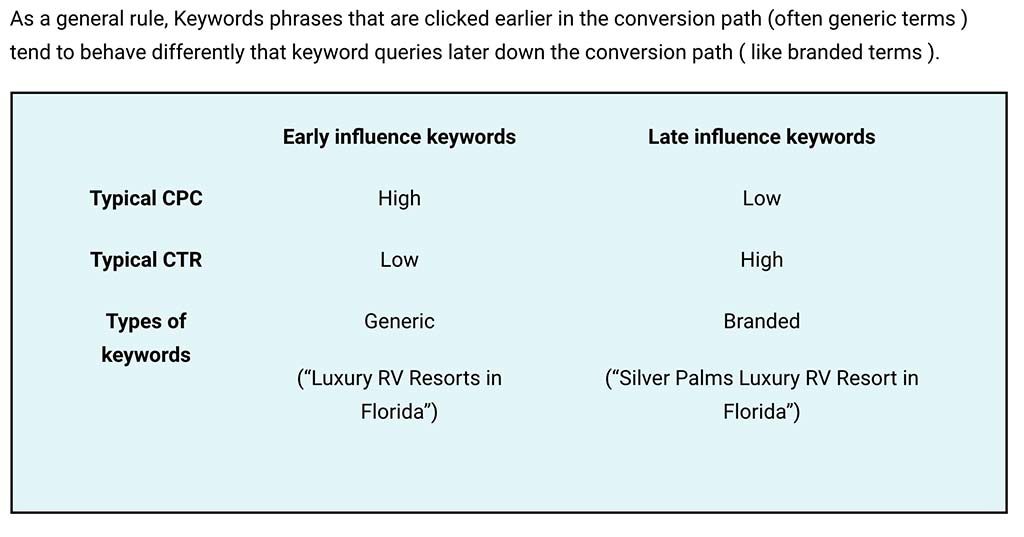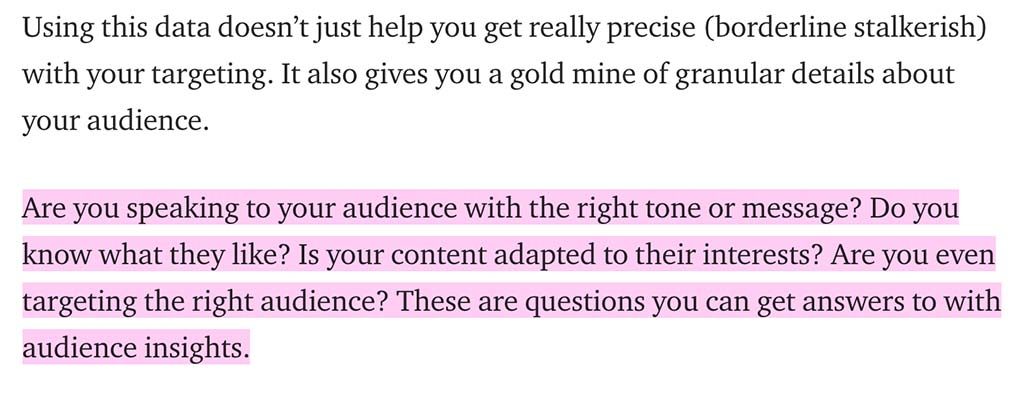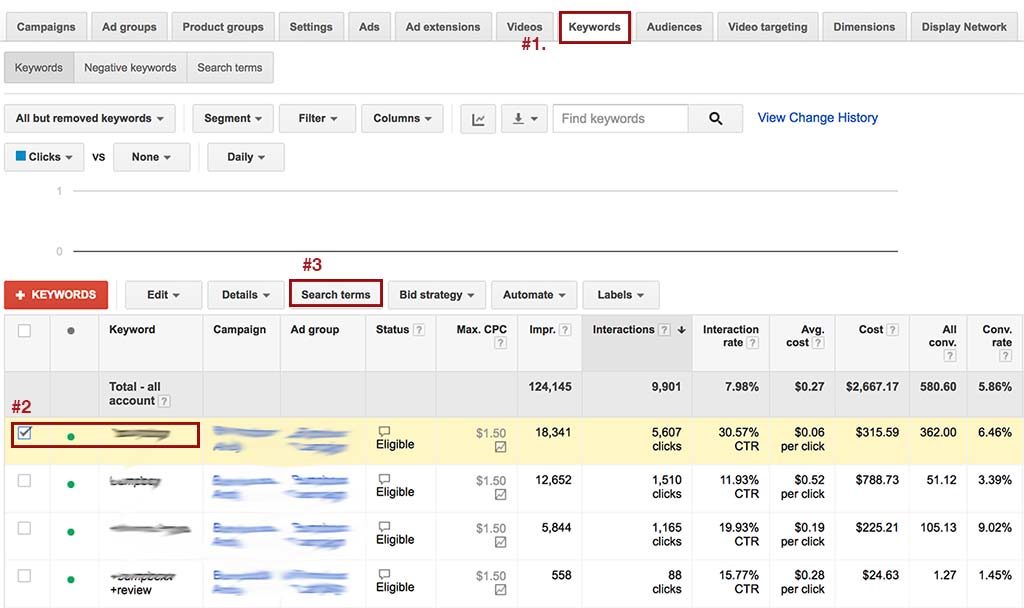Tips for Using PPC Data & SEO Together to Optimize Conversions
[Last revised: September 10, 2018]
Data from Adwords PPC campaigns can be useful for integration with search engine optimization projects. For this PPC data to be useful you should be accurately tracking conversions. With conversion tracking in place, you have the confidence that you are sharing your successful visit information with Adwords. This is also going to make our PPC data more actionable for SEO.
1. Explore the Search Query Report in Google Ads
Use the search phrase report to find keywords that have high search volumes and conversion data. Start with the top performing campaigns and ad groups where you have the most conversion data to work with and use the search phrase report to learn what keyword variants/long tail keywords your campaign may generate. If you aren’t comfortable with match types for keywords, this would be a good time to brush up.
With the details about search terms for the keyword, you selected in the view you will want to sort the list based on conversion activity and see if there are any variants in the list.
The best keyword intelligence is based on what you have running in Adwords because you have accurate search volumes and conversion data. You may find long tail keywords to target with your website or blog that have a great conversion rate.
Grouping some of these keywords by product or service area will help you plan your SEO improvements and potentially give you some new ideas. In some cases, keyword data may influence decisions when it comes to the structure of content on your website.
Don’t Look Past Keywords With Lower Conversion Rates
VAB Media put together a great resource for using attribution modeling to better understand your audience. Insights and understanding the audience is important for making PPC data actionable so it can be integrated with SEO. Having a wider attribution model setup will help us get the most data about the different touch point users experience before they convert.
Imagine how much better your product or service would convert if you could give the users the optimized messaging at each touch point.

If the account is already running well these lower converting keywords (with higher cost CPCs) may target the audience when they are still learning about their needs. Targeting early influence keywords this stage can be expensive. So it can be worthwhile to include higher-converting early influence keywords in your SEO campaign.
Win organic traffic for more “expensive” queries that may be earlier in the buyer’s journey or conversion path.
Keep an eye out for things like comparison queries or product feature queries. This helps fill the top end of your marketing funnel and builds up the remarketing lists.
2. Use Top Performing Ads to Test Headlines and CTAs
Ad performance will help you understand what your customers like best for headlines and ad copy. Again, you have the added value of seeing where the highest converting ads are driving revenue. This should give you a clear picture of the details you should focus on in your content on-site.
You may be able to use top performing ads to help with SEO in these ways:
- Create blog titles or meta titles that have higher CTR from top performing (or split-tested) headlines
- Ideas for new content to create new organic search opportunity based on top ad extensions like site links or callouts (ie. feature pages for SaaS companies)
- Test different offers that may be used on-site to increase conversion rates
This works both ways. Look at your SEO vs. PPC click-through rates and you determine some of the best ad text and meta descriptions based on top performers from both traffic channels.
This only works if your ads are already optimized and you understand what you are actually testing. If you’re not sure where to start when it comes to ad optimization, Wordstream offers a great resource for creating the ultimate text and if you are short on ideas for testing see SearchEngine Land’s 10 ideas to get started testing AdWords copy.
*Bonus* Use Audience Data From Converting Visitors to Optimize Landing Page Content
Making this information actionable is the challenge, but if you can it will be extremely beneficial. Advertising platforms like Adwords and Facebook offer you great insights into what your customers are most engaged with outside of your brand. In this article Joei Chan covers this topic (see #5 about refined SEO strategies). This helps with SEO and PPC conversion optimization.

Both Google AdWords and Facebook have tools that offer deep insights into the makeup of your converting users. Explore those data sets to learn more about your customers and make sure your content is adapted to their interests with the right tone and message. The right messaging starts from the original ad or traffic source and ends at the landing page.
3. Explore Different Attribution Models To Optimize Channel Content
You should choose an attribution model that helps Adwords consider activity from other channels in conversion data. We want Adwords to have that extra data about users who convert so we can learn about how they interact with our ads and content throughout the conversion funnel. We can always get and report on conversions produced by Adwords in Google Analytics if you need single channel attribution data.
In an article for search engine journal, Aaron Levy put together a great article for choosing the best PPC attribution model.
The problem with in-AdWords data-driven attribution is that it’s a single-channel view. While it’ll assess every single aspect of your AdWords data to make a decision, it will only look at AdWords data to make a choice. You’ll have little influence as to whether or not you’re targeting new customers, and you won’t be able to identify conversions that may have come through other non-search efforts like email or social.
By expanding the details of conversion data this can help us understand more about the content users prefer in the conversion funnel. This helps us better understand our audience and find new ways for PPC and SEO can work together. Knowing your customer is very important when you are building your site for search engine optimization.
Advantages of Running Well Integrated SEO and PPC Campaigns
The biggest advantage of running both paid and organic campaigns is the availability to lock up search visibility that one channel or the other may not be able to provide. This can create a well-balanced traffic strategy that aligns very closely with your prospective customers.
PPC helps with search marketing where SEO can be extremely difficult to rank for top converting keywords in your industry. You can invest in a tight target and get a piece of the searches being run each month.
SEO data can help with PPC too. For example, you learn how your users search for content using the on-site search. This can be valuable for keyword targeting in your PPC campaign.
Using data from top performing marketing channels allows you to create a conversion focused experience at every touchpoint.
Looking at how SEO and PPC run together can lead to more efficient marketing and an increase in conversions. If it’s time for a fresh look at your SEO and PPC marketing contact us for an initial digital marketing review.





Comments(02)